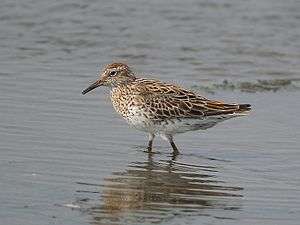Watervalley Wetlands
The Watervalley Wetlands is a nationally important wetland system located in the Australian state of South Australia which consists of a series of contiguous wetlands, lying on 56.6 square kilometres (21.9 sq mi) of private land[2] between the Coorong National Park and Gum Lagoon Conservation Park, in the state's south-east.[1]
| Watervalley Wetlands | |
|---|---|
 Watervalley Wetlands | |
| Location | Murray and Mallee & Limestone Coast regions South Australia[1] |
| Coordinates | 36°28′0″S 140°11′0″E[2] |
| Basin countries | Australia |
| Managing agency | Wetlands and Wildlife Trust South Eastern Water Conservation and Drainage Board[2] |
| Designation | Nationally important wetland[2] |
| Surface area | 56.6 square kilometres (21.9 sq mi)[2] |
| Surface elevation | 15 to 35 metres (49 to 115 ft)[2] |
| References | [2] |

Description
The wetlands comprise Mandina Marshes, Mandina Lake, Cortina Lakes, Mrs Whites Lagoon, Caora and South Flagstaff, which form a chain between relict dune systems inland of the Coorong, about 250 km south-east of Adelaide. The water in the wetlands ranges from fresh to saline according to seasonal conditions. The area has a Mediterranean climate with cool, wet winters and warm, dry summers, and with an average annual rainfall of 450-500 mm. Most of the land is owned by Wetlands & Wildlife, a private conservation and land rehabilitation company, with the remainder expected to become the property of the company in due course.[3]
Fauna
Birds
The site has been identified as an Important Bird Area (IBA) by BirdLife International because it supports over 1% of the world populations of sharp-tailed sandpipers, and sometimes of blue-billed and musk ducks, when water levels are suitable. It also provides habitat for diamond firetails.[4] Other birds of conservation significance present at the wetlands include black-backed and Australasian bitterns, freckled ducks, Australasian shovellers, white-bellied sea-eagles, peregrine falcons, Latham's snipes, Baillon's and spotless crakes, yellow-tailed black cockatoos, southern emu-wrens, chestnut-rumped heathwrens, diamond and beautiful firetails, and black-chinned honeyeaters. The wetlands also support large breeding colonies of several thousand ibises, egrets, spoonbills and cormorants.[3]
Other animals
The site is home to red-necked wallabies and common wombats at the extreme western limit of their range. Rosenberg's goannas are present. Growling grass frogs and Yarra pygmy perch have been recorded.[3]
References
- "Search result for Watervalley Wetlands with the following layers selected - 'suburbs', "NPWSA properties', 'State Gov Regions' and 'Wetlands of National Importance'". NatureMaps. Government of South Australia. Retrieved 21 December 2017.
- de Jong, M.C. (1995). "Search result for 'Watervalley Wetlands - SA064'". Australian Wetlands Database » Directory of Important Wetlands. Australian government. Retrieved 28 December 2017.
- BirdLife International. (2011). Important Bird Areas factsheet: Watervalley Wetlands. Downloaded from http://www.birdlife.org on 2011-11-21.
- "Important Bird Areas factsheet: Gum Lagoon". BirdLife International. 2015. Retrieved 17 September 2015.